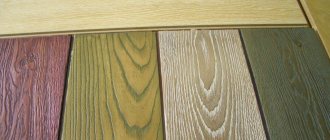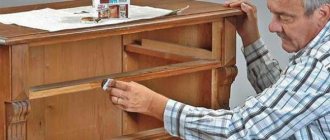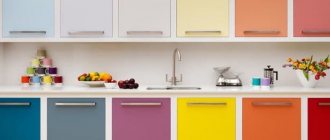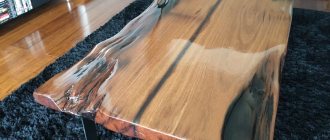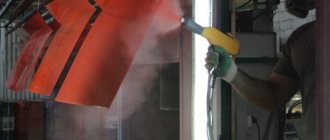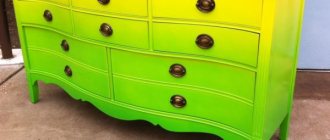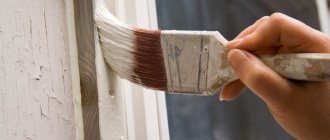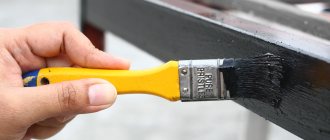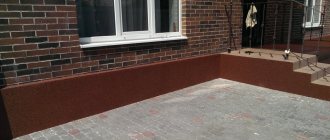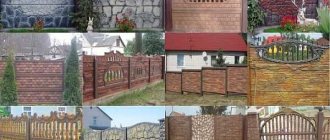Which paint to choose
The wide selection of colorful materials will confuse even an experienced home craftsman. How to repaint a table and, most importantly, what paint to choose? To navigate the huge world of renovation, it is enough to first get acquainted with the types of materials for painting the table.
There is no need to rush to replace it with a new purchase, because such a table can become an interesting design highlight and will help express your creative nature.
Water-dispersed
Water-dispersed acrylic paint is simple and easy to use. Even a beginner can handle it. The product provides an even coating on a wooden surface without lumps or air bubbles. If you don't like the result and the paint has not dried yet, you can wash it off with cold water and start working again. This is handy when you're painting furniture for the first time and don't know what to expect.
This is the best option for furniture that is located in heated rooms, and not on the veranda or terrace.
The non-toxic, safe composition makes the product especially popular for restoring and painting home furniture. When the surface of the table dries after transformation, it acquires water-repellent properties. For a kitchen table this will be a definite plus. Water-based paint is also suitable for outdoor furniture and countertops.
Oily
Oil paint is used less often than others in everyday life, as it has a low degree of wear resistance. It contains drying oil, which is why the painted surface takes a long time to dry.
Over time, oil paint becomes cracked and chipped, loses its beauty and peels off. To work with such a coloring composition, it is necessary to carefully prepare, sand and prime the wooden surface.
To ensure that the surface of wooden furniture is evenly painted, shiny and durable, oil paints are usually used.
Acrylic
Acrylic paints are incredibly popular. They are sold in different containers and aerosol cans. The tabletop can be painted with this product using a roller, brush or spray. Acrylic composition is safe for humans and pets. The paint has no unpleasant odors and dries quickly.
The table can be painted without even taking it outside, right in the kitchen, if you provide a constant flow of fresh air. The paint is resistant to temperature changes, does not crack in the cold and can withstand hot climates. This is a universal product for the home craftsman to update not only the table, but also other furniture.
The only drawback of the product is that it can wear off and fade over time. And also scratches remain due to mechanical impact.
Acrylic paints are water-dispersion compositions that contain polymers, water, pigments and additives that improve the technical properties of materials.
Alkyd
Alkyd enamel can be matte or glossy. By combining such textures you can achieve incredible results in furniture restoration. The product has increased resistance to frost and harsh climates, and is not afraid of either the sun or aggressive chemical compositions of detergents.
Enamel paint is sold in aerosol packaging and in containers. Alkyd enamel is suitable for outdoor furniture.
During operation, an unpleasant acrid odor will be felt, which can cause dizziness, nausea and deterioration. Therefore, you need to prudently acquire a respirator and other personal protective equipment.
Alkyd paint is universal and is intended for application to various surfaces.
Enamels for wooden surfaces
Nitro-enamel paints for wooden surfaces are not widely popular due to their low wear resistance. A tabletop painted with this product quickly becomes unusable due to changes in temperature and exposure to sunlight. If you painted the countertop with enamel paint, the furniture should be constantly in the shade due to sensitivity to ultraviolet radiation.
But such paints are inexpensive, which allows you to update the color of your furniture every season. Due to its toxic composition, the product is best used for street design. Nitro-enamel paints dry quickly, but you should adhere to a complete drying time of 1-2 days.
A high-quality coating can also be created using enamels. They are resistant to light, mechanical stress, and are not subject to corrosion.
Other types of paint
The paint industry provides a wide range of products to repaint a table. When choosing any other paint, make sure that it is intended for painting wooden surfaces. Also, the choice of coloring agent will directly depend on the type of wood. Paint should not only decorate the table, but also protect its structure from the negative influence of the environment, from the penetration of moisture, and from the appearance of mold.
When the coating extends the life of the entire product, it becomes obvious how important the choice of paint is.
Choice of coverage
Modern manufacturers offer a wide range of materials to suit every taste and budget. Let's look at the main features of each coating before we get to work and paint the table.
- Water-dispersed acrylic paint. It is non-toxic, dries quickly after painting, and is easy to use. Even a non-professional can handle it and paint the kitchen table, since it lies evenly on the surface. If it was not possible to paint the table properly, the tabletop can be washed with cold water, but only before the paint has time to dry. After drying, the wooden coating becomes impervious to moisture and is not afraid of ultraviolet exposure.
- Alkyd enamel. The material is suitable for exterior finishing work with a wooden surface, so it is suitable for furniture that stands outdoors. The enamel has a wide range of colors, can be matte or glossy, and is resistant to aggressive detergents, frost and direct sunlight. It is usually used in aerosols, but there is also a liquid option for painting the table. When working, be sure to wear a respirator and be outside or in a non-residential area, since the pungent odor disappears slowly after covering the countertop with enamel. To paint a table with alkyd enamel without harm to health, it is important to follow these precautions.
- Nitro-enamel paints. Very toxic, but dry quickly. Among the advantages are the relatively low cost, and the disadvantages include low thermal stability, the rapid occurrence of cracks after coating due to exposure to ultraviolet rays. You can paint a table with this paint that is in the shade most of the time.
- Oil paint. It is made on the basis of drying oil, so it dries for quite a long time. Used for interior and exterior work on wooden products. Covers the surface with a thin film, but subsequently quickly wears off and peels off. Previously, oil paint was used everywhere, but today, to paint the table, higher quality analogues are used.
How to paint a wooden table correctly
Before you begin the painting process, prepare everything you need for the job.
Selection of tools and paint
When choosing paint, focus on the location of your table. Will it be outdoors or indoors? When you purchase quick-drying dyes, this does not mean that the furniture can be used in a couple of hours. Let the paint dry for at least a day, preferably two. The coating must not only dry, but also harden so that small efforts or mechanical actions do not leave dents.
If the paint is not water-based, then it will be better that the entire process of painting wood does not take place in the living room.
When you have decided on the coloring composition, allocated time and space, outlined and thought through the design, it’s time to prepare the necessary materials. You will need:
- various paint brushes and paint rollers;
- paint sprayer if the countertop is large or you have several pieces of furniture;
- a paint tray where you can pick it up with a brush or roll it out with a roller;
- antiseptic for wooden surfaces to prevent mold;
- a primer that will prevent the paint from being absorbed into the wood and provides an even, beautiful coating;
- gloves, respirator, safety glasses and other personal protective equipment;
- chemical reagents or a wire brush to pre-prepare the countertop for painting in order to remove old paint or varnish;
- pieces of cloth and old newspapers to remove smudges and drops.
The materials used to paint old boards must be of high quality.
Surface preparation
Preparing a countertop for painting requires some skill. But this stage cannot be skipped. If you apply new paint to an old coating or varnish, the surface of the table will soon become covered with new cracks and chips. Sanding, cleaning the countertop from old paint fragments, puttying, eliminating cracks and depressions provides excellent adhesion between the wood and the fresh paint layer.
Allow the primer to dry thoroughly before applying the first coat of paint.
- If you are painting the entire table, take it apart into pieces. If you plan to refresh only the countertop, then this procedure is not necessary.
- Using a sanding machine, a stiff brush or sandpaper, prepare the surface of the furniture to be restored. Remove any remaining varnish or old paint, level the surface, and eliminate all unevenness and roughness. The more thorough the preparation at this stage, the better the paint will adhere.
- Apply primer. It is desirable that it be the color of the future paint. If you plan to paint it white, choose a primer of the appropriate shade.
- Cover with masking tape the areas that you do not plan to paint. It is better to prevent the dye from getting onto unwanted areas than to wash off the blots later.
- Have a rag handy to wipe your hands or any fallen drops. It is also recommended to cover the floor with newspapers or film so as not to stain the floor with paint.
If the surface is covered with regular paint, then large areas are painted with wide brushes, and small details and corners should be covered with a thin brush.
Painting process
The painting process is fun and even creative. The future appearance of the entire table will depend on how you paint the surface.
- Prepare the area for painting, remove all unnecessary items, put on protective clothing and gloves. Cover the floor with unnecessary newspapers, film or paper.
- If you have spray paint, shake the can thoroughly before use. All components inside should be mixed.
- If you have paint in a can, pour a little of the product into a special tray or tray. This will make it easier for you to dip your brush or roll out your roller.
- When painting, spread the paint evenly over the wooden surface. Try to apply thin layers and let them dry. It is better to do several such approaches than to apply paint tightly at once. This coating dries slowly, forms smudges and bumps, and is easy to deform and leave marks.
- Each layer must dry thoroughly before applying the next. Only in this case will the surface of the table be painted evenly, without bald spots or gaps.
- Paint the tabletop first, and then the legs and other parts. Make it a rule to move from large planes to smaller ones. Lastly, paint the decorative elements and fittings.
- It is better to do a multi-layer coating, apply the coloring composition at least 2-3 times.
- If you want a slight wood grain and roughness, lightly sand the surface after the tabletop is dry.
- After the product has completely dried, you can apply varnish.
- The protective tape can be removed after all layers have dried.
After the parts have dried, acrylic varnish is applied on top. So, the surface will be resistant to mechanical damage.
Drying the table
Painted furniture should dry for a day or two in a well-ventilated area or outside in a shady area. Do not touch or check the surface with your finger. Assemble the furniture only after all parts have dried; do not screw the legs to the tabletop until the drying process is complete. It is important to protect your freshly painted table from flying insects. Otherwise, they may stick to the surface and leave marks.
After the allotted time has passed, you will be able to use the updated furniture.
Dyeing technology
Before you paint a wooden table, you need to arm yourself with:
- with a brush, roller and container (if paint is used) or spray (aerosol);
- goggles, mask, gloves, respirator (to avoid toxic substances getting into and on the body);
- antiseptic (necessary for protection against insects) and wood primer (reduces paint consumption).
Painting the table is carried out on a hard surface, previously covered with newspapers or plastic wrap to avoid paint getting on the floor. For those who decide to cover the table with varnish or non-water-based paint, it is better to carry out the restoration outdoors due to the strong toxic odor. If the piece of furniture is large enough, it is better to disassemble it into its component parts using a screwdriver, hammer drill, etc. Many experts argue that it is not worth violating the integrity of a wooden object, since in the future it may lose its shape. However, this statement is controversial. If you assemble all the parts together correctly and efficiently, this will not affect the life of the product, and it will be easier to paint.
Features of table decoration
When the paint is completely dry and hardened, it's time to start decorating. There are several techniques you can use at home. They are good because they do not require expensive investments and are easy to create at home. This is a great option for updating a child's room.
- Decoupage. For this technique you will need napkins with a beautiful pattern, brushes and PVA glue. Select the topmost layer of paper with a decorative element, attach it to the tabletop and apply glue on top with a brush. Make sure that the napkin does not tear, form air bubbles, or move from its original position. After the glue has completely dried, the decorative element is coated with transparent varnish.
- Tulle. Find a piece of tulle with a beautiful pattern. Wet the material, apply it to the table surface and fix it. Using spray paint or a brush, paint the tulle fabric evenly. After drying, remove the improvised stencil. It will look especially impressive if you use contrasting colors of the paint composition.
- Artificial aging of wood looks stylish in a home interior. To do this, sand the surface of the table with sandpaper and wipe certain areas with ammonia. When they darken, go through sandpaper again and varnish.
- Patination. This method produces beautiful, dark, vintage stains on a wooden surface. Apply the patina using stain or other suitable means, wait until it dries and remove unnecessary layers with a foam sponge.
Painting other types of tables
In addition to the dining table, there are ladies', magazine, desk and others. The large number and variety of species sometimes confuses the master. The more complex and ornate the decor, the more careful painting of all the nuances is required. In such cases, it is better to use a spray gun or aerosol cans.
The finely sprayed coloring composition gets into hard-to-reach places where no brush, much less a roller, can reach.
If you want the wood grain to show through, don't use a pre-primer. Choose liquid paints that will not additionally level the surface of the furniture. This coloring composition will repeat the relief of the wood.
If you want a smooth desk, such as a desk, choose thick enamel with a matte finish.
Matte paint is a stylish and modern finish for furniture.
Step-by-step painting algorithm
- We are disassembling the table that we will paint and decorate. Carefully unscrew the legs, table top, and drawers.
When disassembling furniture, do not forget to mark the installation location of each of the parts, this way you will not get confused and will complete the task faster.
This way you can reduce the number of layers applied later.
If the surface is covered with regular paint, then large areas are painted with wide brushes, and small parts and corners should be touched with a thin brush.
A little patience, attention and accuracy in your work, and painting a table with your own hands will be easy and quick.
How to update and paint a very old table
Very old furniture usually has damage, dents, chips and cracks. There is unnecessary texture in the form of a bug-eaten surface. The fittings have already loosened, the legs have become loose and the tabletop is slightly “wobbly”. It’s not enough to just repaint such furniture; it needs to be repaired and restored.
To begin, disassemble the table into as many components as possible. Wash the surface of the table top and legs, dry and examine carefully. All damage and dents can be smoothed out using putty and primer. Tighten the fittings or replace them with new ones.
Old tables are often made from good, strong wood that will last for many years to come.
Painting the table white
White furniture shades come with warm or cool undertones. In the first case, yellow, orange and reddish shades are mixed with the white color. If the interior is made in cold colors, add a little green or blue to the white paint.
How to paint a children's table with your own hands if it is dark in color? To pre-treat the countertop, choose brightening pastes or primers in white shades. This will allow you to repaint even the darkest furniture. Each layer of the painted surface must dry thoroughly. The finish can be matte or glossy. For extra shine, coat the table with varnish. In this case, the white furniture will literally shine.
For an antique effect, you can choose materials to paint in the desired color and completely cover the surface, wait until it dries, then carefully remove part of the top layer with a sponge.
Benefits of painting furniture yourself
What are the benefits of painting yourself?
- Confidence in the quality of work performed.
- Possibility to choose the desired color and dyeing method.
- Such furniture is easier to “fit” into the interior.
- It's easy to bring new ideas to life or simply restore individual pieces of furniture.
Painting is one of the fastest and most effective techniques in furniture decor.
Main difficulties and mistakes
Common mistakes can lead to unexpected results. This can ruin your mood and furniture. Therefore, follow a few rules and do not make mistakes common to beginners.
- Dilute the paint in the proportions indicated in the instructions. This is important so that the paint does not turn out to be too thick or, on the contrary, liquid. Failure to follow these simple recommendations will result in drips and uneven coverage.
- The product must dry well. If you start using the table before the paint has completely dried, there is a risk of leaving dents, fingerprints, dark spots or scratches on the tabletop.
- Poor grinding of the surface makes it uneven and bumpy. Even if it is not noticeable, after painting, especially in light colors, all the flaws will be noticeable.
- Insufficient putty also reduces the lifespan of finished furniture. If you think that the legs need not be puttied, then over time the cracks and damage will only increase in size. Such a table will quickly become unusable. Do not ignore inconspicuous areas and loose fittings, repair and update everything on time.
- Test the paint on a small area of the product. Does it apply well, are you satisfied with the result, how many layers do you plan to apply? It is advisable to decide on these nuances in advance so as not to improvise on the fly with an unexpected result.
There are a great variety of decor options, and the result of a home craftsman’s creative search will be limited only by the flight of his imagination, time and materials.
No. 3 Painting method using a candle
Worn white paint, through which in some places you can see the wood itself in its natural color, is wonderful when restoring antique furniture or creating new ones, but in the same style.
In the photo below you can see an example of such painting of wood with wonderful designer pens laid out on it.
Instructions:
- Take a clean wooden board (no matter sanded or not) and a candle. Rub the candles onto the surface of the wood in several places. You need to press quite hard on the candle so that a clear trace of wax or paraffin remains on the wood.
- After this, paint the wood with white paint and let it dry completely.
- Wipe the dry painted surface with a rag, applying some pressure. In those places where there was a trace of a candle, the paint will come off the surface.
Below is an example of a white wood floor painted using this method. It is worth noting that when using this, it is better to apply a layer of protective varnish on top of the paint for more durable use.
Rules for caring for a painted table
The painted surface does not require special care. But there are unacceptable things that can disrupt the smoothness or texture of the decorative coating.
- Wipe a varnished or polished table only with soft cloths or microfiber. Do not use rough sponges, scrapers or cloth with fittings. This may leave marks or scratches on the countertop.
- If you have varnished the surface of the furniture, do not clean it from dust using a wet method. This removes the natural shine and makes the varnished table matte. Remove dust using a special broom or vacuum cleaner.
- An unpolished surface can be washed, but so that the water does not stagnate. Immediately remove excess liquid and wipe the countertop dry.
Depending on the paint chosen, the wood may absorb water and swell.
Painting a table at home is easy. The main thing is to follow simple rules, safety precautions and use your imagination. Perhaps the process of painting a table will captivate you so much that you will become seriously interested in restoring furniture in your home.
Remember that there are always many opportunities to give old furniture a new life with your own hands.
Necessary materials
The materials used to paint old boards must be of high quality. You need to choose only high-quality materials for painting and priming.
For the entire restoration or painting process you will need:
- Antiseptic for wooden surfaces;
A wood antiseptic is necessary to protect wood from mold and fungi, the so-called blue stain, and harmful insects.
The primer helps improve the adhesion of the coating to the boards and reduces paint consumption.
Wooden products need protection. Varnishes are used for this purpose.
When performing repair work, we inevitably deal with solvents for varnish, enamel, and paints.
Masking tape is a tape based on a slightly rough paper layer.
You need to cover the area where you will paint the table with newspapers.
It is not the smell itself that is harmful, but the volatile compounds in the paint - solvents. They are toxins for the nervous and hematopoietic systems.
